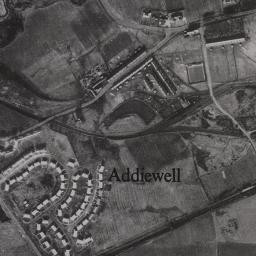Street names old

Aerial view of Addiewell as the old rows were being removed and the new village built. Probably late 1940s or 1950s
West Lothian Local History Library. All rights reserved.
Street names in the old village, and the derivation of the names Addiewell and Loganlea
Addiewell
Earliest known forms of the names: Awdyweill (1512); Adieweel (1792)
Derives from the Scottish personal name, Adie, meaning Adam, + well ; therefore the meaning of the name is ‘Adam’s well’.
Loganlea
The old name was Muirhousedykes – the dykes (walls) of the house on the moor.
In the eighteenth century, the estate of Muirhousedykes was bought by a minister, the Rev. Patrick Logan, who changed the name to Loganlea.
Old street names
Baker Street - Named after Sir Benjamin Baker who designed the Forth Railway Bridge. (Thank you to Gerard Cosgrove for this information.)
Bank Street – It is recorded in a reminiscence of early days in Addiewell as Banks Street, so possibly named after Sir Joseph Banks (1743-1820), naturalist and botanist. Or possibly Bank Street, as it may have been the location of the Addiewell Penny Savings Bank.
Campbell Street - Probably named after a scientist of that name, but which is not known
Davy Street – after Sir Humphry Davy (1778-1829), inventor of the Davy safety lamp for miners.
Faraday Place – named after Michael Faraday (1791-1867), an early pioneer of electricity, electromagnetism and electrochemistry.
Graham Street – named after Professor Thomas Graham (1805-1869), who was James Young’s professor of chemistry when he was a student and a young scientist. Made important discoveries in dialysis and diffusion of gases.
Livingstone Street – named after David Livingstone (1813-1873), the missionary and explorer, who was a close friend of James Young.
Simpson Street – named after Sir James Young Simpson (1811-1870), of Bathgate, who discovered the anaesthetic properties of chloroform.
Stephenson Street – named after Robert Stephenson (1803-1859), who invented the first steam locomotive.
Watt Street – named after James Watt (1736-1819), the inventor of the first efficient steam engine. Developed the concept of horsepower.